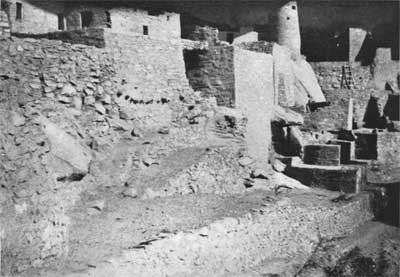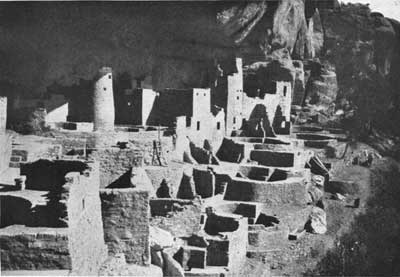
|
ANTIQUITIES OF THE MESA VERDE NATIONAL PARK
CLIFF PALACE
By JESSE WALTER FEWKES
GENERAL FEATURES
Cliff Palace (pls. 1, 2), the most instructive
cliff-house yet discovered in the Mesa Verde National Park, if not in
the United States, is one of the most picturesque ruins in the
Southwest. While its general contour follows that of the rear of the
cave in which it is situated, its two extremities project beyond the
cavern. The entire central part is protected by the cave roof; the
ends are exposed.
The general orientation of Cliff Palace is north and
south, the cave lying at the eastern end of the canyon of which it is an
extension. The southern end is practically outside this cave, and the
few rooms westward from kiva V are unprotected. An isolated kiva, W,
with high surrounding walls, is situated some distance beyond the
extreme western end of the ruin. Although not in the same cave as the
main ruin, certain other rooms in the vicinity of Cliff Palace may have
been ceremonially connected with it. They are built in shallow
depressions in the cliffs and may have been shrines or rooms to which
priests retreated for the purpose of performing their rites. In the
category of dependent structures may also be mentioned numerous rings of
stones on top of the mesa. The existence of calcined human bones in the
soil over which these stones are heaped indicates the practice of
cremation, of which there is also evidence in the ruin itself.
DESTRUCTION BY THE ELEMENTS
The constant beating of rain and snow, often
accompanied in winter by freezing of water in the crevices of the
masonry, has sadly dilapidated a large part of the front walls of Cliff
Palace, especially those at the northern and southern ends (pl. 3) where
they do not have the protection of the overhanging roof of the cave.
While the sections known as the old quarter, the
plaza quarter, and much of the tower quarter are protected by the roof
of the cave, even here there has been exposure and destruction from the
same cause. Torrential rains on the mesa in the late summer form streams
of water which, following depressions,a flow over the rim of the
cave roof and are precipitated into the trees beyond the lowest terrace
of the ruin. The destruction of walls from these flows is much less than
that from smaller streams which, following the edge of the cave roof,
run under the roof and drip on the walls, washing the mortar from
between the component stones, and eventually undermining their
foundation and leading to their fall. The former presence of these
streams is indicated by the black discoloration of the cave roof shown
in photographs.
aIn some of these waterways are found good
examples of "potholes," some of considerable size, which often retain
water for a long time. Their capacity was increased in prehistoric
times by the construction of dams.
A visitor to Cliff Palace in the dry season can
hardly imagine the amount of rain that occasionally falls during the
summer months, and it is difficult for him to appreciate the destructive
force it exerts when precipitated over the cliff. When Cliff Palace was
occupied, damage to walls could be immediately repaired by the
inhabitants after every torrent, but as the ruin remained for centuries
uninhabited and without repair, the extent of the destruction was
great. The torrents falling over the ruin not only gain force from the
distance of the fall, but sweep everything before them, bringing down
earth, stones, small trees, and bushes. At such a time the bottom of the
canyon is filled with a roaring torrent fed by waterfalls that can be
seen at intervals far down the gorge. The observer standing in Cliff
Palace during such a downpour can behold a sheet of water falling over
the projecting cliff in front of him. These cataracts fortunately are
never of long duration, but while they last their power is
irresistible.b
bWhile there has probably been considerable
erosion in the bed of the canyon since Cliff Palace was constructed,
this does not mean that "the action of the water carved out the valley,
leaving at an inaccessible height buildings originally constructed on
almost level land." See History N. Y. State Chapter, Colorado Cliff
Dwellings Assoc., p. 11.


Plate 9. MAIN ENTRANCE (top), SOUTHERN END, SHOWING REPAIRED TERRACES
(bottom)
|
VANDALISM
No ruin in the Mesa Verde Park had suffered more from
the ravages of "pot hunters" than Cliff Palace; indeed it had been much
more mutilated than the other ruins in the park (pls. 1, 4, 5). Parties
of workmen had remained at the ruin all winter, and many specimens had
been taken from it and sold. There was good evidence that the workmen
had wrenched beams from the roofs and floors to use for firewood, so
that not a single roof and but few rafters remained in place. However,
no doubt many of the beams had been removed, possibly by cliff-dwellers,
long before white men first visited the place.
Many of the walls had been broken down and their
foundations undermined, leaving great rents through them to let in light
or to allow passage from the debris thrown in the rooms as dumping
places. Hardly a floor had not been dug into, and some of the finest
walls had been demolished.a All this was done to obtain pottery
and other minor antiquities that had a market value. The arrest of this
vandalism is fortunate and shows an awakened public sentiment, but it
can not repair the irreparable harm that has been done.
aSome, possibly considerable, of this
mutilation may be ascribed to the former occupants. The Ute Indians will
not now enter cliff-dwellings and probably are not responsible for their
destruction.
REPAIR OF WALLS
The masonry work necessary to repair a ruin as large
and as much demolished as Cliff Palace was very considerable. The greatest
amount was expended on those walls in front of the cave floor hidden
under the lower terraces, at the northern and southern extremities. The
latter portion was so completely destroyed that it had to be rebuilt in
some places, while at the southern end an equal amount of repair work
was necessary. (Pls. 3, 6, 7, 9.) To permanently protect these sections
of the ruin the tops of the walls and the plazas were liberally covered
with Portland cement, and run-ways were constructed to carry off the
surface water into gutters by which it was diverted over the retaining
walls to fall on the rock foundations beyond. It would be impossible
permanently to protect some of these exposed walls without constructing
roofs above them; at present every heavy rain is bound to cover the
floors of the kivas with water and thus eventually to undermine their
foundations.
The preservation of walls deep in the cave under
protection of the roof was not a difficult problem. The work in this
part consisted chiefly in the repair of kiva walls, building them to
their former height at the level of neighboring plazas.
MAJOR ANTIQUITIES
Under this term are embraced those immovable objects
as walls of houses and their various structural parts—floors,
roofs, and fire places. These features must of necessity be protected in
place and left where they were constructed. Minor antiquities, as
implements of various kinds, stone objects, pottery, textiles, and the like,
can best be removed and preserved in a museum, where they can be seen to
greater advantage and by a much larger number of people. The ideal way
would be to preserve both major and minor antiquities together in the
same neighborhood, or to install the latter in the places in which they
were found. While at present such an arrangement at Spruce-tree House
and Cliff Palace is not practicable, large specimens, as metates and
those jars that are embedded in the walls, have, as a rule, been left as
they were found.
As the repair work at Cliff Palace was limited to the
protection of the major antiquities, the smaller objects for the greater
part having been removed before our work began, this report deals more
especially with the former, the whole ruin being regarded as a great
specimen to be preserved in situ.
Very little attention was given to labeling rooms,
kivas, and their different parts, the feeling being that this experiment
has been sufficiently well carried out at Spruce-tree House, an
examination of which would logically precede that of Cliff Palace.
Spruce-tree House has been made a "type ruin" from which the tourist can
gain his first impression of the major antiquities of the Mesa Verde
National Park, and while it was well to indicate on its walls the
different features characteristic of these buildings, it would be
redundant to carry out the same plan in the other ruins.a
aThe author's hope is to excavate and repair
in different sections of the Southwest a number of "type ruins," each of
which will illustrate the major antiquities of the area in which it
occurs. From an examination of these types the tourist and the student
may obtain, at first hand, an accurate knowledge of the prehistoric
architecture.
No attempt was made to restore the roof of any of the
Cliff Palace kivas for the reason that one can gain a good idea of how
the roof of a circular kiva is constructed from its restoration in Kiva
C of Spruce-tree House, and an effort to roof a kiva of Cliff Palace
would merely duplicate what has already been accomplished without adding
essentially to our knowledge.
|

|



